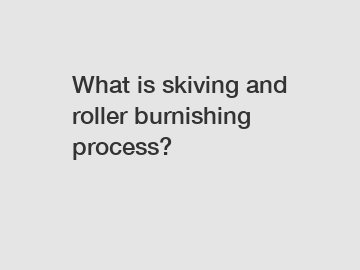What is skiving and roller burnishing process?
Skiving and roller burnishing are two essential processes used in the manufacturing industry to improve the surface finish and dimensional accuracy of cylindrical components. These processes are widely used in various industries, including automotive, aerospace, and hydraulic systems. In this article, we will explore what skiving and roller burnishing processes entail and their importance in achieving high-quality parts.
Skiving Process:
Skiving is a metal cutting process that involves removing material from the surface of a cylindrical component using a specialized skiving tool. This process is typically performed on tubes or bars made of metals such as steel or aluminum. The skiving tool has multiple cutting edges that remove a thin layer of material from the workpiece while rotating. The tool is also moved longitudinally along the axis of the workpiece to achieve the desired dimensions and surface finish.

1. Benefits of Skiving:
Skiving offers several advantages in the manufacturing process. First, it helps to reduce the overall size and weight of cylindrical components, making them more efficient and cost-effective. Additionally, skiving improves the surface finish of the workpiece by eliminating any imperfections or defects, thus enhancing its aesthetic appeal. Furthermore, skiving can produce precise dimensions and tight tolerances, making it suitable for high-precision applications.
Roller Burnishing Process:
Roller burnishing is a finishing process that enhances the surface texture and hardness of a workpiece by applying high pressure using a roller tool. This process is typically performed after skiving or turning to achieve a superior surface finish. The roller burnishing tool consists of multiple hardened and polished rollers that rotate and pass over the surface of the workpiece, exerting a compressive force.
2. Advantages of Roller Burnishing:
Roller burnishing offers several benefits in terms of part functionality and appearance. Firstly, it improves the hardness and wear resistance of the workpiece, making it more durable and reliable. Secondly, roller burnishing enhances the surface finish by creating a smooth and mirror-like appearance. This is especially essential in applications where aesthetic appeal is crucial, such as decorative components or high-end equipment. Moreover, roller burnishing eliminates the need for secondary operations like grinding or polishing, reducing production time and costs.
In conclusion, skiving and roller burnishing processes are crucial for achieving high-quality cylindrical components in various industries. Skiving helps to remove material and improve surface finish, while roller burnishing enhances surface texture and hardness. These processes offer numerous advantages, including reduced size and weight, improved dimensional accuracy, and reduced production time. By implementing skiving and roller burnishing, manufacturers can ensure the production of efficient, durable, and aesthetically pleasing components.
If you have any further questions or would like to learn more about skiving and roller burnishing processes, please do not hesitate to contact us. Our team of experts is readily available to assist you in achieving exceptional surface finishes and precise dimensions for your cylindrical components.
For more customized long stroke hydraulic cylinder, customized multi stage telescopic hydraulic cylinder solutio, skiving roller burnishing machine suppliersinformation, please contact us. We will provide professional answers.
138
0
0


Comments
All Comments (0)